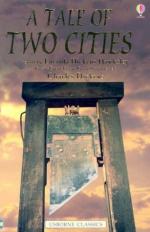|
This section contains 5,610 words (approx. 19 pages at 300 words per page) |

|
SOURCE: “Dickens and the Catastrophic Continuum of History in A Tale of Two Cities,” in ELH, Vol. 51, No. 3, Fall, 1984, pp. 575-87.
In the following essay, Rignall discusses the relationship between “narrative form and historical vision” in A Tale of Two Cities.
It is not surprising that the most remembered scene in A Tale of Two Cities is the last, for this novel is dominated, even haunted, by its ending. From the opening chapter in which the “creatures of this chronicle” are set in motion “along the roads that lay before them,” while the Woodman Fate and the Farmer Death go silently about their ominous work, those roads lead with sinister inevitability to the revolutionary scaffold.1 To an unusual extent, especially given the expansive and centrifugal nature of Dickens's imagination, this is an end-determined narrative whose individual elements are ordered by an ending which is both their goal and...
|
This section contains 5,610 words (approx. 19 pages at 300 words per page) |

|


